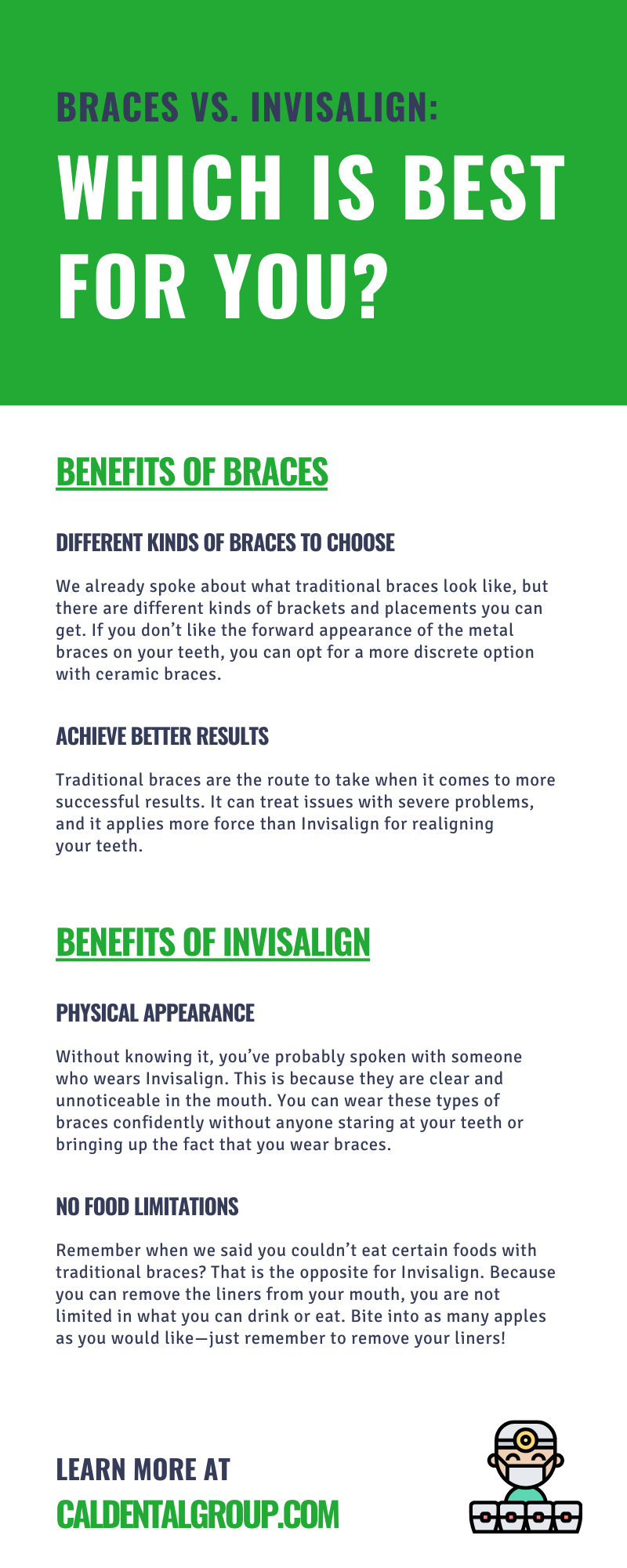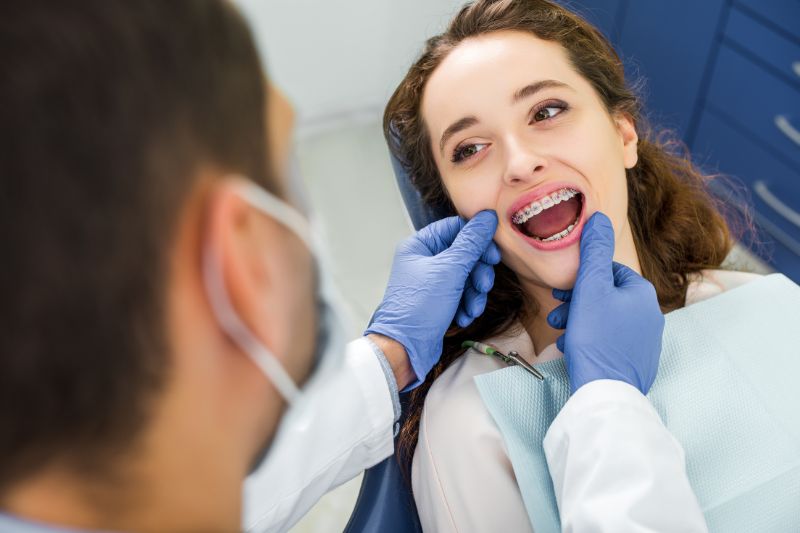The two most popular options for adjusting and realigning your teeth are braces and Invisalign—but which is best for you? In this article, we overview the difference between these two orthodontic devices and the benefits and disadvantages of each. Keep reading to make an informed decision on which one to choose for your oral health.
What Is the Difference Between Braces & Invisalign?
When you use traditional braces, your orthodontist will cement metal brackets onto your teeth and use wires to slowly pull your teeth into alignment over time. With Invisalign, your dental provider will take an impression of your teeth that is then used to create multiple clear plastic liners that fit over your teeth to shift them into position. Essentially, braces physically bind to your natural teeth, while Invisalign is a removable product.
Benefits of Braces
To better understand if traditional braces are right for you, consider the benefits they offer.
Different Kinds of Braces To Choose
We already spoke about what traditional braces look like, but there are different kinds of brackets and placements you can get. If you don’t like the forward appearance of the metal braces on your teeth, you can opt for a more discrete option with ceramic braces. Or you and your orthodontist might choose a lingual placement—brackets that fit on the inside of your teeth. Either way, you have the option to choose braces that are less noticeable.
Perfect for Complex Corrections
Not everyone will share the same experience with braces or need the same type of treatment. The use of traditional brackets and wires can correct a multitude of conditions ranging from minor to complex issues. For example, with straightening your teeth, your dentist may need to also realign your bite, which requires additional orthodontic devices—such as rubber bands or forsus—that you cannot use with Invisalign.
Unremovable
Having semi-permanent and unremovable braces might not seem beneficial, but it is helping you in the long run. With Invisalign, you can remove the liners; however, with traditional braces, you will wear them 24/7, which requires less responsibility from you. You won’t need to worry about how long you’re wearing the braces because they won’t come off—which makes this method mindless for the patient.
Achieve Better Results
Traditional braces are the route to take when it comes to more successful results. It can treat issues with severe problems, and it applies more force than Invisalign for realigning your teeth.
Disadvantages of Braces
With benefits come disadvantages. While traditional braces might seem like the perfect solution, this orthodontic method has a few drawbacks.
Limitations With Food
Because you cannot remove the braces from your mouth, the brackets will limit the kind of food you can consume. For instance, prepare to not eat any apples or corn with traditional braces, since you could accidentally break off or crack a bracket. You won’t be able to safely consume any super chewy or crunchy foods until you are no longer wearing braces.
More Orthodontic Appointments
You will need to visit the orthodontist more frequently with braces because your provider needs to physically monitor your progress and exchange some of the hardware in your mouth for different components. You will need to do this regularly to ensure the treatment plan is going accordingly.
Mouth Discomfort
When braces sit on your teeth, they can initially feel crowded and unfamiliar. The same will happen when you go in for adjustments. You will feel discomfort around your teeth for a short period of time until your mouth adjusts to the new wire or hardware.
Teeth Staining
The brackets the orthodontist cements to your teeth will remain in place until your braces are ready for removal and treatment is complete. If you do not do an excellent job of keeping up with your oral hygiene, you can be left with stains on your teeth after removing the brackets. Counteract this by brushing your teeth twice daily and flossing.
Benefits of Invisalign
Now that you have a better idea of what traditional braces entail, you can familiarize yourself with their counterpart, Invisalign! First, let’s look at this orthodontic device’s benefits.
Physical Appearance
Without knowing it, you’ve probably spoken with someone who wears Invisalign. This is because they are clear and unnoticeable in the mouth. You can wear these types of braces confidently without anyone staring at your teeth or bringing up the fact that you wear braces.
No Food Limitations
Remember when we said you couldn’t eat certain foods with traditional braces? That is the opposite for Invisalign. Because you can remove the liners from your mouth, you are not limited in what you can drink or eat. Bite into as many apples as you would like—just remember to remove your liners!
Fewer Orthodontic Appointments
You are less likely to have as many appointments with Invisalign. Generally, you will need a few appointments with your orthodontist to ensure you’re progressing in your treatment. However, any adjustment is simple, and you can do it yourself by simply swapping out your liners for new ones.
Better Comfort
While it might feel a little odd to have a plastic liner covering your teeth, you’ll quickly adjust. With Invisalign, you will feel better comfort on a daily basis, and it won’t be as uncomfortable to make adjustments when you need to start wearing a new liner.
Disadvantages of Invisalign
For more information on whether braces or Invisalign are best for you, consider the disadvantages of Invisalign.
Self-Discipline
When you wear braces that are removable, you must have self-discipline to reap the benefits. If you spend more than half of your day without wearing your Invisalign, the treatment cannot work correctly, and you’re ultimately wasting money without seeing progress. While it is fine to remove the liners from time to time, you will need to wear them for at least 22 hours a day for the treatment to work.
Treats Minor Conditions
The ideal patient for Invisalign will only have minor issues with their teeth. This means if you have any severe problems, liners cannot help, and you will likely need traditional braces. After your orthodontist examines your mouth, they can conclude whether you could benefit from Invisalign or if you have larger issues that need help from brackets and wires.
Frequent Teeth Brushing
Invisalign will completely cover your natural teeth, so if you’re not brushing or taking care of your oral hygiene, you will be locking in the bacteria and plaque when you wear the liners. It’s vital that your teeth are clean before wearing Invisalign. This could mean brushing your teeth between meals and snacks multiple times a day to ensure you’re not leaving plaque on your teeth and covering them with liners.
Tooth Attachments
While you typically only need an impression done before the lab creates your plastic liners, you may need small attachments on your teeth that help hold the Invisalign in place. Not everyone will need these, but they are sometimes necessary to keep everything inside your mouth. Think of these attachments as buttons that fit into the liner to keep it from falling out of your mouth.
The bottom line, what type of braces are best for you will depend on the severity of your issues, your self-discipline, and your personnel preference. Talk with your dental provider today about whether you could benefit from braces and the options they have available to you. Consider contacting our offices at Cal Dental Group to learn about our professional orthodontic services to restore your smile!


